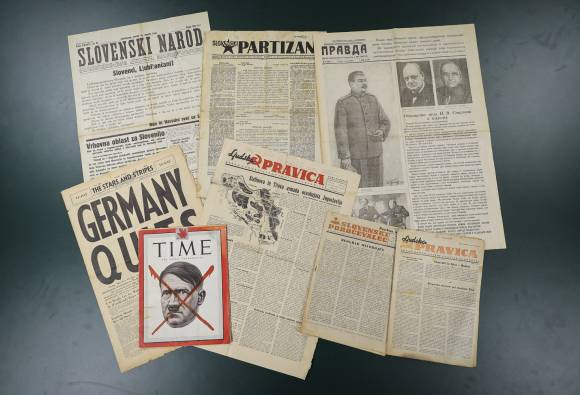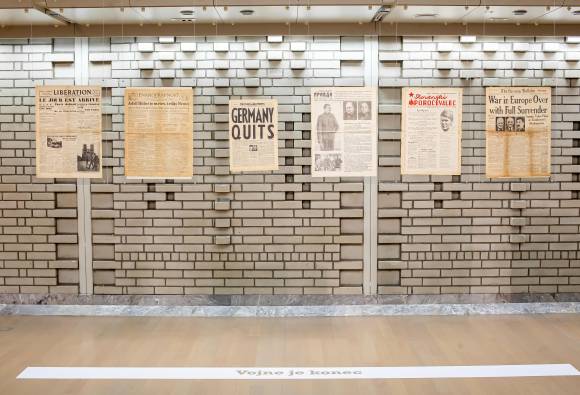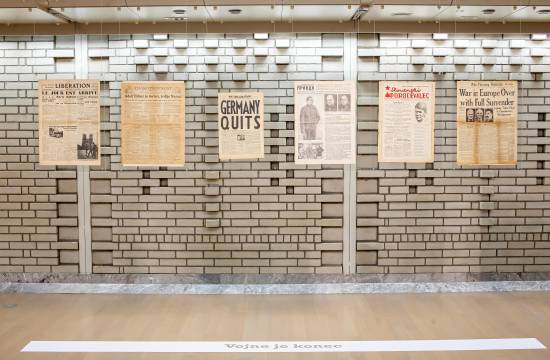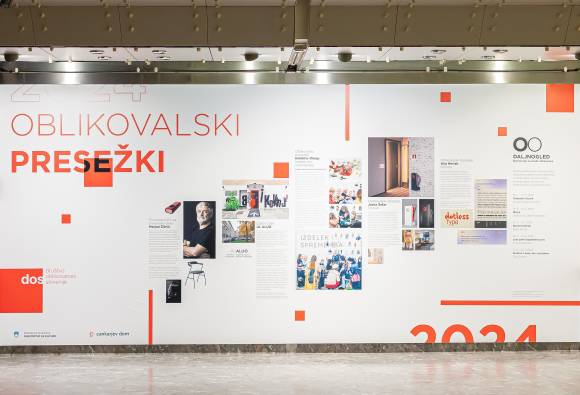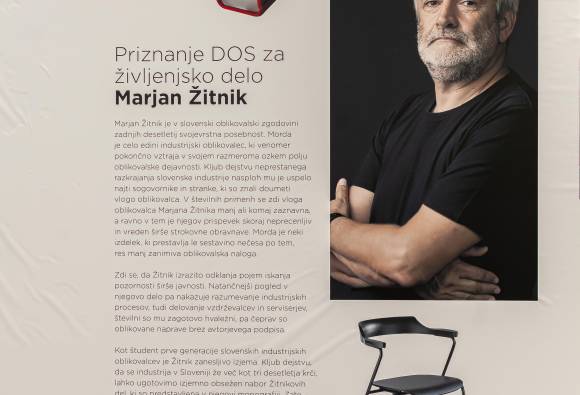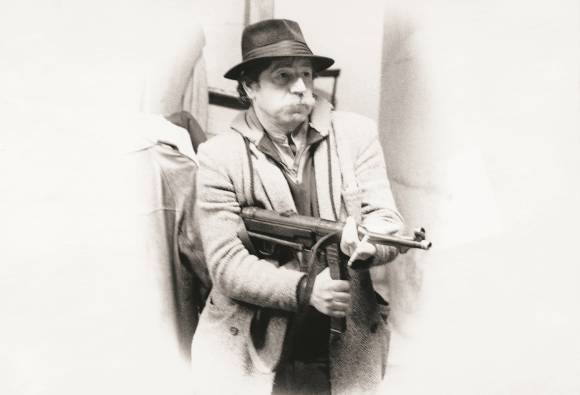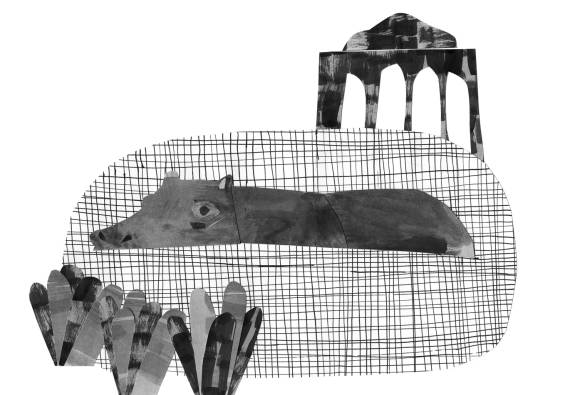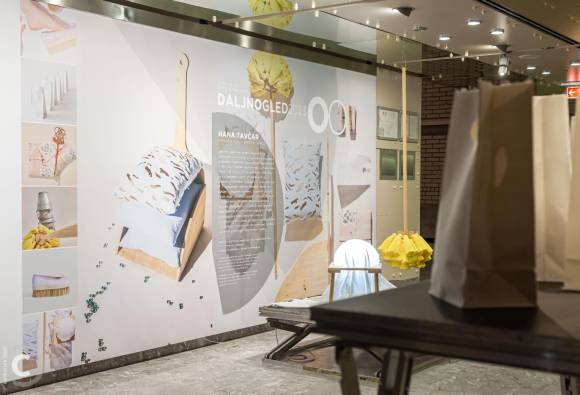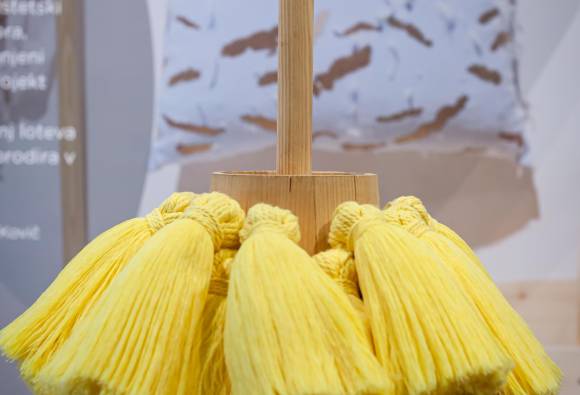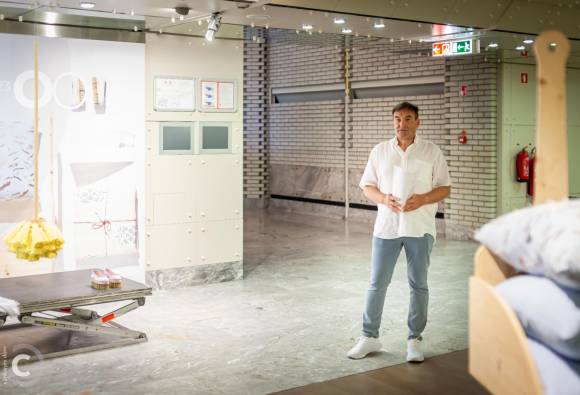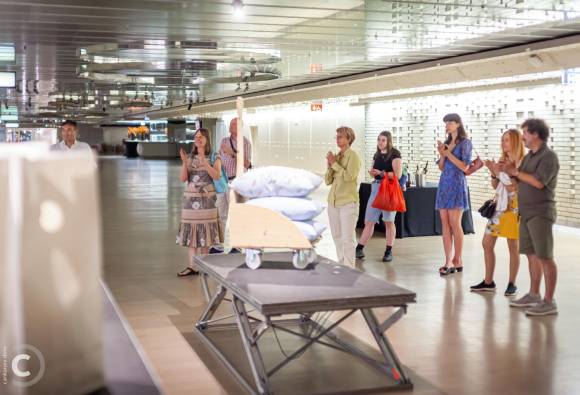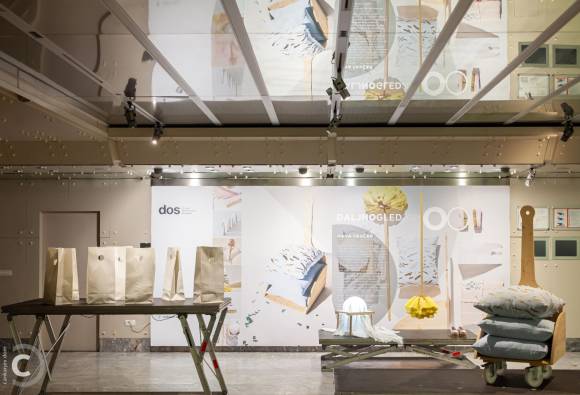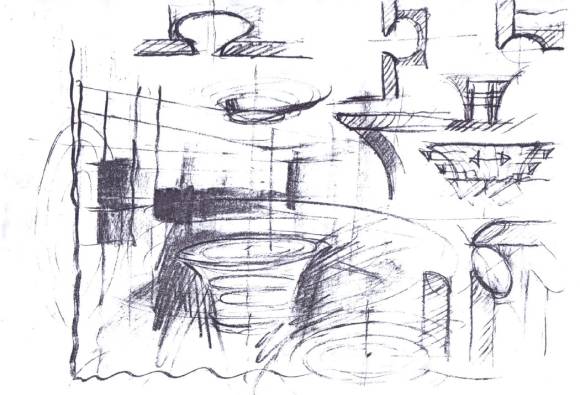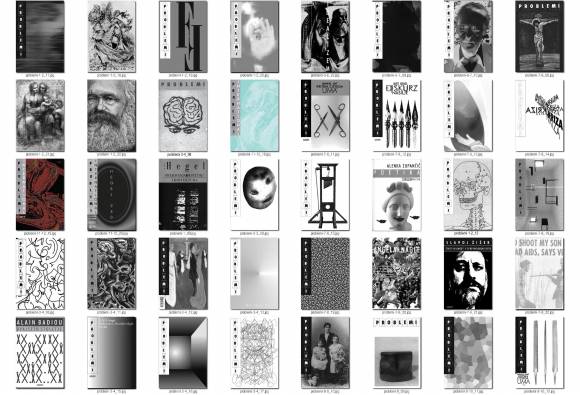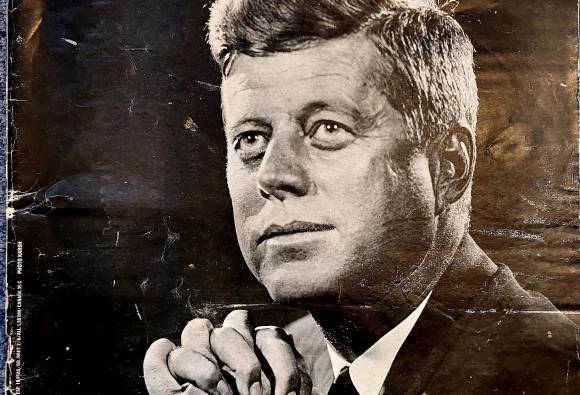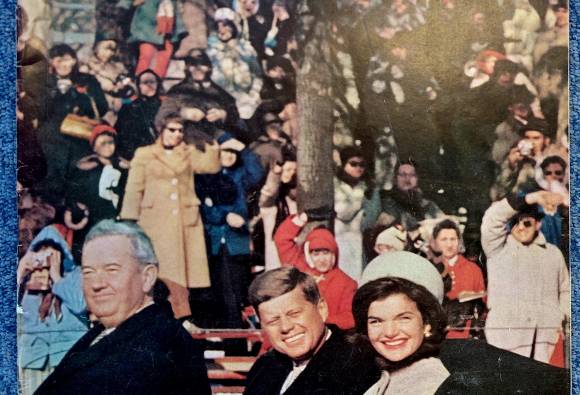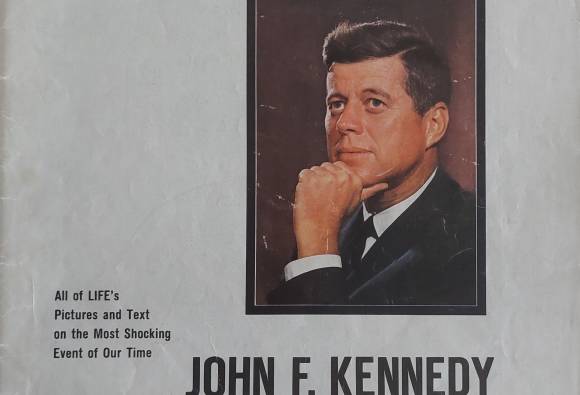The 1939–45 period on newspaper covers

Six Years of War, One Day of Liberation
The 1939–45 period on newspaper covers
9 May marks 80 years since the end of the Second World War in Slovenia. Just three months later, the bloodiest military conflict in human history came to an end in Asia. The rise, violence and collapse of Nazism and fascism received real-time newspaper coverage. The printed media, which documented the gradual approach of war, its eruption, its rampage and its end, is one of the material relics of that time. This upcoming round anniversary is the last of its kind celebrated by the resistance fighters. The youngest will soon be a hundred years old. In ten years' time, their testimonies will be gone.
The Museum of Press has been collecting old copies of newspapers reporting on World War II at flea markets, attics, basements, garage sales, antique shops and auctions. The collection has been more than two decades in the making. Some of the newspapers were published underground, distributed by couriers. Some were published in large print runs in parts of the world untouched by the war. The content of the newspapers is by no means homogeneous. Some newspapers glorified Hitler, some Stalin. At the same time, details printed more than 80 years ago are an ominous echo of modern times. Readers will be hard pressed not to notice parallels between Hitler's claims relating to Czechoslovakia or Poland and those of the present-day rulers.

OUTSTANDING ACHIEVEMENTS IN DESIGN – Designers Society of Slovenia DOS
This year marks an important anniversary for Slovenian design. In 1984, the establishment of the Department of Design at the Academy of Fine Arts in Ljubljana represented the beginning of design education.
That is why the Designers Society of Slovenia decided to award prizes – to the Academy of Fine Arts and to Marjan Žitnik, a first-generation student and graduate of the Academy of Fine Arts.
The Designers Society of Slovenia is awarding an honorary membership to the Academy of Fine Arts in Ljubljana, and a lifetime achievement award to Marjan Žitnik, in recognition of four decades of continuous work in the field of industrial design.
DOS Lifetime Achievement Award
Marjan Žitnik
Marjan Žitnik occupies a unique place in Slovenian design history of the last decades. He may even be the only industrial designer noted for his unwavering commitment to a relatively narrow field of design activity. Despite the fact that Slovenian industry in general has been constantly diminishing, he has succeeded in finding partners and clients with a proper understanding of what the role of the designer involves. In many cases, Marjan Žitnik's role as a designer seems to be less or barely visible, but this is precisely where his contribution is virtually invaluable and merits wider professional recognition.
A closer look at his output shows an understanding of industrial processes, including the work of the maintenance and repair technicians, many of whom are undoubtedly grateful to him, even though the devices he designed do not bear his signature.
As a student of the first generation of Slovenian industrial designers, Žitnik is definitely an exception. Although the industry in Slovenia has been diminishing for more than three decades, Žitnik’s output – presented in his monograph – stands out as an exceptionally prodigious and versatile legacy.
DOS – Outstanding Achievement in Design 2024
Oloop Collective for the exhibition and research project PRODUCT AS CHANGE
On view at the DLUL Gallery between 5–14 January 2025
The Designers Society of Slovenia judging panel recognised the social role of the project Product as Change by the Oloop group as an outstanding achievement in space (the exhibition) and time. In life, change is the only constant. Over the last decade, the field of design has proven the validity of this fact.
Meeting individual needs through various products, which designers have contributed to (and continue to contribute to), and which by definition are supposed to make work and life physically easier for every individual on a daily basis, extends to meeting the deeper inner mental and emotional needs of the individual. The role of design is therefore changing. This trend – i.e. change and social need – has been recognised by Oloop, a collective known for projects that employ inclusive, collaborative and co-creative approaches and processes.
DOS Design Achievement Award
Alja Herlah
Dotless type
Dotless type is a digital platform that primarily provides support to young typographic designers, offering opportunities for presentations – type releases – and seeking to motivate them to complete their projects. Many beginners have accomplished no small feats through their research, but unfortunately most of them are relegated to little more than a footnote and barely on the radar of the professional community and the wider public.
DOS Design Achievement Award
Jasna Šafar
Florian
In attempting to domesticate the fire extinguisher and adapting it to any environment and space, Florian is an interesting product. We do not see Florian as a definitive solution to an ideal camouflage, but rather as a broader challenge to the design profession, which over the years has paid scant attention to fire safety devices and the like.
OUTSTANDING ACHIEVEMENTS IN DESIGN – Designers Society of Slovenia DOS
Admission free

The Srebrenica Genocide
Breaking news unable to break the wall of conscience
Exhibition opening: 22 January at 18.00, Cankarjev dom's Foyer I
Breaking news unable to break the wall of conscience, an exhibition launching the commemorative programme dedicated to the 30th anniversary of the Srebrenica genocide, provides a shocking insight into the press coverage of one of the greatest human tragedies since World War II, the Srebrenica genocide. Through a selection of newspaper headlines and clippings from the Slovenian, Bosnian and world press, selected by Ali Žerdin, the exhibition shows how news of these events seeped out to the public – and how the world remained powerless in the face of the impending catastrophe.
Each exhibited cover is doubly significant: as a historical record and as a reminder that our indifference allows for unchecked repetition of such tragedies. The message of the exhibition is clear. We knew. But we did not act decisively (enough). Not only giving insight into past events, the exhibition also raises questions about the role of the media, the authorities and each individual in confronting injustice and preventing genocide.
Reminding us that we were aware of these events but failed to prevent them, Breaking news unable to break the wall of conscience invites us to reflect deeply on inaction and collective responsibility.
The exhibition forms part of the commemorative programme "8372 Living Memories" marking the 30th anniversary of the Srebrenica genocide. The programme is implemented by the MKC Cultural and Educational Institute in cooperation with and through the support of partners. The semi-annual commemoration includes various activities aimed at preserving the memory of the victims and raising public awareness. For more information on the programme activities and the Srebrenica genocide please visit www.srebrenica.si.
The memorial events 8372 Living Memories marking the 30th anniversary of the Srebrenica genocide is held under the auspices of the President of the Republic of Slovenia Dr. Nataša Pirc Musar.
The Srebrenica Genocide: Breaking news unable to break the wall of conscience
Admission free

Production: Slovenski gledališki inštitut (Slovenian Theatre Institute) and Cankarjev dom
Exhibition authors: Dr Matic Kocijančič, Dr Gašper Troha and Primož Jesenko, MA
Exhibition co-authors: Tea Rogelj, MA, Ana Perne, Katarina Kocijančič, Sandra Jenko, MA
Design: Sanja Jurca Avci, Tomaž Budkovič, Dolores Gerbec
The playwright and director Dušan Jovanović occupies a prominent place in the history of the late 20th-century Slovenian and Yugoslav theatre. He was born in 1939, just before World War II, into a family with Greek, German, Croatian as well as Serbian ethnic origins. He spent his early childhood in Skopje and Belgrade and later moved to Slovenia with his father. He was an incomer, a foreigner who grew to become a theatre reformer and a daring playwright. His unending search for new ways of theatrical staging and intellectual provocations left a permanent imprint on the world of theatre. First with the Študentsko aktualno gledališče (Student Relevant Theatre), and later the Eksperimentalno gledališče Glej (Experimental Theatre Glej) and Gledališče Pupilije Ferkeverk (Pupilija Ferkeverk Theatre). His influence was most felt at the Mladinsko Theatre, where he served as Artistic Director from 1978 to 1985. Dušan Jovanović gained international renown, making his mark both in Slovenia and throughout the former Yugoslavia, as a theatre director in Serbia, Croatia, Bosnia and abroad.
As well as directing for the theatre, Jovanović made a name for himself as a prolific playwright. Oder 57, one of the first experimental theatres in post-war Slovenia, included Norci (The Madmen) in its repertoire but had been closed down before the play was staged. However, Jovanović did not admit defeat. The play was premiered seven years later at SLG Celje. He blazed new trails in avant-garde drama, for example with Znamke, nakar še Emilija (Stamps, and then Emilija), and broke with experimental theatre in Igrajte tumor v glavi in onesnaženje zraka (Play a Tumour in the Head and Air Pollution). In the late 1970s, his Osvoboditev Skopja (The Liberation of Skopje) and Karamazovi (The Karamazovs) laid the foundations for political drama, a savagely personal piece of theatre. His explorations of taboo subjects drew large crowds to theatre houses from Australia to the United States.
He is credited with reforming the Yugoslav theatre, thus earning notoriety as a cultural terrorist: the critic Josip Vidmar, who rejected these newly introduced phenomena, coined this term for a specific group of theatre practitioners (Dušan Jovanović, Ljubiša Ristić, Janez Pipan, Slobodan Šnajder, Rudi Šeligo...). As an all-round intellectual, in addition to engaging in theatre, Jovanović wrote essays on social reality, and later also poems and prose. He inspired the next generation of theatre artists as a professor at the Academy of Theatre, Radio, Film and Television – AGRFT, University of Ljubljana. Although his ambition to stage a production at Ljubljana’s Plečnik Stadium was thwarted, it testifies to his belief in the importance of striving for the impossible.
The Dušan Jovanović – Cultural Terrorist exhibition, to take place in Cankarjev dom’s Foyer I between 14 January – 7 March, addresses various aspects of Dušan Jovanović's work. It focuses on his directorial oeuvre, highlighting the phenomenon of The Liberation of Skopje, takes viewers back to the 1980s and the rise of the Mladinsko Theatre, presents Jovanović's plays and other publications, and shows – through the testimonies of his students – his influence on the younger generations. The exhibition seeks to capture Jovanović's spirit, infused with innovation, provocation and passion.
The exhibition is accompanied by the first comprehensive monograph on Dušan Jovanović, to be published by the Slovenian Theatre Institute, as well as the following side events:
29 January 2025 – Scientific symposium marking the publication of the monograph on Dušan Jovanović, with the participation of the authors of various chapters – Darja Dominkuš, Sebastijan Horvat, Hrvoje Ivanković, Aleksandra Jovičević, Milan Mađarev, Aldo Milohnić, Saša Pavček, Janez Pipan, Draga Potočnjak, Alja Predan, Tomaž Toporišič, Gašper Troha and Dragan Živadinov
8–10 February Screenings of three films dealing with Jovanović’s productions or screen adaptations of Jovanović’s plays – Vsaka dobra zgodba je ljubezenska zgodba about the 1993 staging of Boris, Milena, Radko (dir. Rajko Grlić, Matjaž Ivanišin, 2017); Delanje Leara about the 1993 production of King Lear (dir. Damjan Kozole, 1993); and Osvoboditev Skopja (dir. Danilo Šerbedžija and Rade Šerbedžija, 2016).
Produkcija: Slogi, Cankarjev dom

Art Critics’ Choice ... Illustrations:
Ana Maraž
Artist Presentation Series selected by the Slovenian Art Critics Association
Critic: Tatjana Pregl Kobe
A selection of book illustrations
Ana Maraž’s selection for this year’s Illustrators Exhibition in Bologna, a main showcase for the latest trends in illustration for children and young adults, her given her work a new lease of life. At first glance, a minimalist approach and a flat style enhanced by the illustrator's primary, abstracted interpretation feature prominently in her work. Through the use of different approaches, this is beautifully represented by her illustrations for the four selected books. The anthology of fairy tales by Mate Dolenc, Kako dolg je čas (Beletrina, 2019), seems a perfect match for the symbolism of the illustrator Ana Maraž, and the black and white colour palette was a logical choice. The most prominent double-spread illustration shows a hippopotamus in a lake outside a spa, a tropical salad and a spa pavilion – depicted in an extremely symbolic way (pen and wash drawings, lines done in Indian ink, collage), and a perfectly balanced layout of the spread. Another, extremely challenging commission was illustrating Miroslav Košuta's poems in his book Božaj veter – Pesmi za mlade (Mladinska knjiga, Sončnica, 2021). The colour range is deliberately sparse, with only shades of blue and green added to the red. Using a unique artistic approach, this time significantly different, Maraž has succeeded in capturing expectations, nimbleness, tenderness, the gloominess of the forest, a garland of dried flowers and wind in hair. Her innovative and unconventional artistic language gained international visibility immediately after the publication of the picture book Protideževna juha by the writer Majda Koren (KUD Sodobnost International, 2023). The illustrations were selected for the main showcase of the Bologna International Children's Book Fair, and went on to tour Japan, Korea and China. The sensual illustrations in mixed media, accompanying Kaja Teržan's poems in the tiny, brightly coloured picture book Narisati ptico (Mladinska knjiga, Knjižnica Čebelica 480, 2024) for the youngest readers, are masterfully done. The continuous thread that runs through Ana Maraž’s body of work is symbolism, the artist’s vehicle for opening windows onto new worlds to the viewers.
Ana Maraž (1985, Šempeter pri Gorici). Graduated in Art Pedagogy from the Faculty of Education, the University of Ljubljana, in 2011. Since 2017, she has been working in the field of illustration as a self-employed professional in culture. Her illustrations have been published in magazines and books for children and young readers. She has held several solo and group exhibitions in Slovenia and internationally. Maraž is the recipient of several important national and international awards. She is a member of the Illustrators' Section of the Slovenian Association of Fine Arts Societies. She lives and works in Vipava.
Tatjana Pregl Kobe (1946, Maribor) Holds a BA in Art History, and works as an art critic, writer and essayist. Her most notable professional achievement are regular contributions to scholarly journals dedicated to this genre, the book Slovenska knjižna ilustracija (1979/80), a publication charting the development of illustration throughout the world Upodobljene besede (1998), publications in books Likovne impresije I–III (2000–2007) and the book Slovenska knjižna ilustracija 1 (2023). She is on the editorial board of the Otrok in knjiga journal and frequently serves on the jury of various Slovenian and international biennials of illustration. She lives in Ljubljana.
Art Critics’ Choice ... Illustrations: Ana Maraž
Admission free
Admisson free

Hana Tavčar: Umazani posli / Dirty Business
DOS Young Designers Award
In collaboration with the Designers Society of Slovenia
Young artist Hana Tavčar's textile art project, Dirty Business, is a witty and innovative narrative about everyday household utensils and work that human society considers inferior.
Brooms, rags, brushes, sinks, dustpans, dustbins are hidden behind cupboards in our day-to-day living spaces, in pantries, under counters, behind doors. By adding various textile elements, the artist places them in a different context, where they come to life taking on a new role; they become inviting, proud, aesthetic and valuable co-creators of a living space, cleansed of prejudice and stigma and elevated to the status of desirable pieces of family heirloom. The project is a highly felicitous fusion of tradition and contemporaneity, which, in addition to social issues, also addresses the field of sustainability and insightfully penetrates the complex psychology of modern man.
Mentors: Prof. Marija Jenko, Assist. Prof. Katja Burger Kovič, MSc
Faculty of Natural Sciences and Engineering, Department of Textiles, Graphic Arts and Design, University of Ljubljana
Hana Tavčar: Umazani posli / Dirty Business
Admission free

Embryonic STROKE
Drawing As The Starting Point For The Development Process
ANTHROPOLOGICAL APPROACH – REFLECTION ON THE INTERPRETATION OF THE PRIMORDIAL IDEA
A selection of works by the Designers Society of Slovenia
Curator & selector: Prof. Vid Lenard
Project Manager: Jurij Dobrila
The Embryonic STROKE of a Designer
A Greek myth says that the history of painting and all artistic media begins with the drawing. Thus, as the outline of a shadow cast by bodies, drawing constitutes the starting point of the development of art and design.
The Embryonic STROKE exhibition foregrounds the popularity and relevance of drawing among Slovenian members of the Designers' Society of Slovenia (DOS). As has been established, a hand drawing remains the crucial, extremely useful medium in both design and art (e.g., Risomanija exhibition, Nova Gorica, 2024), although today perhaps occupying a different role. This is because it enables an immediate recording of thoughts, impressions and feelings, which makes it relevant and popular. Drawing is quick and direct, it represents the fastest transference from thought to hand, allowing for a wide range of subjects and a whole array of expressive possibilities. A drawing can be a transfer of thoughts onto paper, perhaps a sketch in the sand, or even a plastic interpretation of ideas in random spatial material. A drawing can be a brief verbal note or a coherent interpretation of an idea.
In the field of design, drawings are a medium for thinking and working, for concretising or elucidating ideas; they are a means of presenting a project to a client or the authorities; and a way to reflect on analysing and presenting the basic concept of a project. A model – drawing therefore both concretises and externalises the inner world of a designer and their ideas. It helps the designer to reflect on the project and ways towards perfecting it.

Zala Hrastar: Vrtičkanje, prtičkanje
Oblikovalska identiteta – ciklus Daljnogled
V sodelovanju z Društvom oblikovalcev Slovenije
Umetniški projekt Vrtičkanje, prtičkanje mlade tekstilne oblikovalke Zale Hrastar je domišljen razmislek o življenjskih kontrastih, ki jih spretno združuje skozi uporabo digitalne in rokodelske tehnike. Središče tega projekta predstavljajo stari prtički, ki so preoblikovani in kolažirani v funkcionalne tekstilne mojstrovine.
Projekt tako izraža sinergijo med preteklostjo in sedanjostjo, preoblikovanje dediščine v nekaj novega, inovativnega in privlačnega.
Poleg tega ima projekt pomembno vlogo pri spodbujanju pomena recikliranja in ponovne uporabe rabljenega tekstila.
Avtorica si zato zasluži priznanje za ohranjanje prepoznavne vizualne identitete in kakovostnega umetniškega dela, ki presega čas in modne trende.
Projekt je nastal v sodelovanju z mentoricama Marijo Jenko in Petjo Zorec; NTF – Univerza v Ljubljani.
Priznanje DALJNOGLED razpiše in podeljuje Društvo oblikovalcev Slovenije ter je namenjeno mladim ustvarjalcem, ki ob prijavi dela še niso dopolnili trideset let. Avtor ali skupina avtorjev prejme priznanje za najboljši odgovor na razpis oziroma izziv, razpisan pri DOS.
Predsednik Društva oblikovalcev Slovenije: Jurij Dobrila
Predsednik žirije oblikovalski presežki: Peter Jamšek
Oblikovanje razstavne postavitve: Anka Štular
Fotografija: Zala Hrastar

Alen Ožbolt: SILVER WINDOWS
An exhibition of the Society for Theoretical Psychoanalysis cover designs – the ANALECTA collection, the PROBLEMI Journal and the Razpol Newsletter of the Freudian Field
It has been three decades since Alen Ožbolt took over designing the PROBLEMI magazine and the ANALECTA book collection. Thirty years and more than 200 book covers – an imposing output and one virtually unparalleled in the publishing industry. Thirty years of book covers, designs all sharing the same starting point, but each and every one singularly unique, and nearly all alluding to the content with great subtlety. A book cover is a window onto the book, and these book jackets are the main focus of Cankarjev dom's Silver Windows exhibition.
The exhibition includes accompanying reflections by Dr. Mladen Dolar and Dr. Alenka Zupančič, and Gray on Gray, a series of lectures by great philosophical figures to take place in January and February 2024.

Historical Memory, Newspaper’s Third Dimension
Exhibition marking the 60th anniversary of the assassination of John F. Kennedy
Author: Ali Žerdin
John F. Kennedy, the 35th president of the United States, was assassinated 60 years ago, on 22 November 1963, in Dallas. Appearing on all TV channels and delivering eloquent speeches, Kennedy was a president whose life was front-page news, whose words went down in history as famous quotes. An icon, a mythical figure, a physically weak man of athletic appearance, a powerful, promiscuous man giving an impression of a modest family man.
The newspaper copies kept by the Museum of Press present his dazzling public image. JFK’s assassination was a global media sensation - like the Moon landing.
Historical Memory, Newspaper’s Third Dimension
Free entrance
